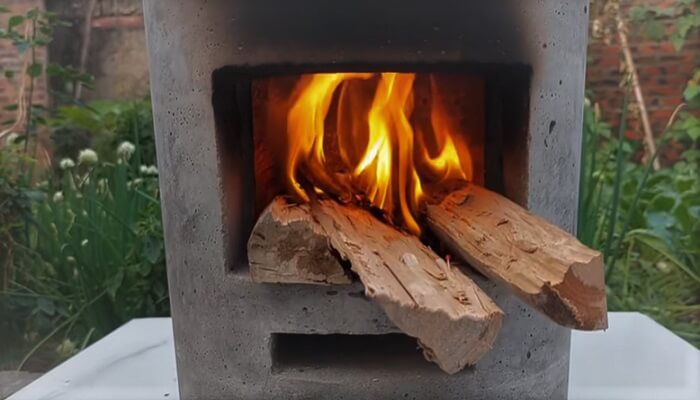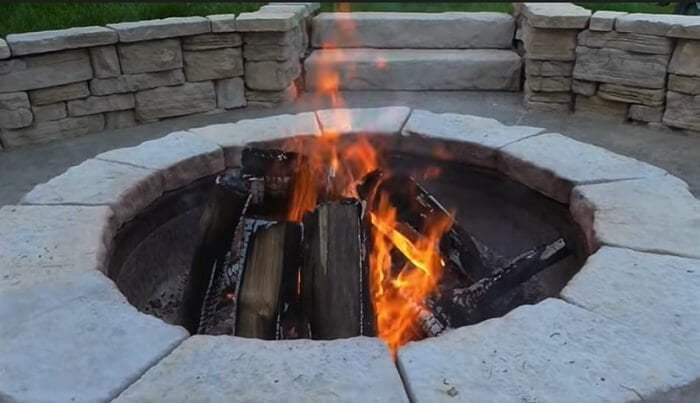Can You Burn Wet Wood in Your Fire Pit, Stove, or Fireplace?
Note: This article may contain affiliate links, which means if you make a purchase following our links won’t cost you extra, but we may earn a commission. Learn more
Burning wet wood in your fire pit, stove, or fireplace is not safe. It is vital to use dry, seasoned wood to facilitate efficient combustion, minimize smoke production, prevent creosote buildup, and maintain a safe and enjoyable fire experience.
Burning wet wood in your fire pit, stove, or fireplace is not safe and poses several risks. Wet wood contains a high moisture content, making it difficult to ignite and sustain a proper fire. This results in inefficient combustion, producing more smoke and less heat.
Apart from diminishing the warmth and ambiance of your fire, burning wet wood also releases harmful pollutants into the air, which can have adverse effects on both your health and the environment.
Also, burning wet wood can lead to the accumulation of creosote in your chimney or flue. Creosote is a highly flammable substance that forms when wood combustion is incomplete and smoke cools down.
Over time, creosote can build up, increasing the risk of chimney fires. It is therefore important to use dry, seasoned wood to minimize the formation of creosote and ensure the safety of your fireplace or stove.
If you find yourself with wet firewood, it is crucial to properly dry it before burning. This can be achieved by storing the wood in a dry, well-ventilated area for at least six months. Splitting the wood into smaller pieces can help expedite the drying process.
By ensuring the firewood has a moisture content of around 20%, you can promote efficient combustion, reduce smoke production, and maximize heat output.
It is also worth noting that burning wet wood outside can result in excessive smoke and a nuisance to your neighbors. The smoke can linger for extended periods and negatively impact air quality. To ensure a pleasant and eco-friendly experience, it is best to use dry firewood specifically intended for outdoor fires.
Dangers of Burning Wet Wood
To burn wood in your fire pit, you need to be aware of the dangers of burning wet wood. Wet wood can produce a lot of smoke and can even cause your fire to flare up. Burning wet wood is dangerous for a number of reasons.
First, the water in the wood can create intense heat and flames. This can cause the fire to spread quickly and unpredictably, leading to injuries or even death.

Second, wet wood produces a great deal of smoke. This smoke contains harmful chemicals that can cause respiratory problems, especially in children and the elderly. Also, The smoke from wet wood can be a nuisance to your neighbors and can also cause health problems.
Third, the flames from a wet wood fire can be very high and uneven and can easily spread to nearby buildings or trees. If the fire gets out of control, it can be very difficult to put out.
Fourth, burning wet wood creates less heat than burning dry wood. This means that you will have to burn more fuel to get the same amount of warmth, which increases your carbon footprint and contributes to climate change.
Fifth, burning wet wood can also cause bad odors. If you don’t want your fireplace smelling bad, you should avoid burning wet wood.
Therefore, it is important to burn only dry wood in your stove or fire pit or to dry wet wood yourself before burning.
Read More: Fire Ring vs. Fire Pit: When and Which One Should You Have?
How to Dry Out Wet Firewood Fast?
Drying out wet firewood is important to get the most heat output from your wood and to prevent any potential for mold or fungus growth. If you want your wet firewood to dry quickly, there are a few things to keep in mind.
- Split the logs into smaller pieces. This will help them dry out faster by exposing more surface area to the air.
- Stack the wood in a well-ventilated area, such as near an open window or door, or outside if it’s not too cold.
- Cover the top of the stack with a tarp or other waterproof material to keep rain from soaking through and rewetting the wood.

If you’ve ever had the misfortune of trying to burn wet wood in a fire pit, you know it’s not a fun experience. The wood pops and hisses emitting a lot of smoke and doesn’t produce much heat. If you find yourself in a situation where you need to dry out wet firewood fast, here are some tips to help you get the job done:
- Gather up as much wood as you can find and put it in a dry, sheltered location.
- If it’s raining, cover the wood with a tarp or something else to keep the rain off of it.
- If you have a fan, set it up so that it’s blowing on the wood. It helps to evaporate the moisture.
- If you have a dehumidifier, set it up near the wood pile. This will help to remove the moisture from the air, which will in turn help to dry out the wood.
- You can also try setting the wet wood in front of a space heater or other heat source. Just be sure to keep an eye on it so that it doesn’t catch fire.
- If you have access to a kiln, that’s the best way to dry out wet wood fast.
- If you don’t have a kiln, you can try building a solar oven. This is a bit more of a DIY project, but if you’re up for it, it can be a great way to dry out wet wood fast.
- Another option is to build a wood-drying rack. This is essentially a frame that you can set the wet wood on so that it can dry out.
- You can also try using a wood stove or fireplace to dry out the wet wood. Just be sure to keep the fire going at a moderate temperature so that you don’t damage the wood.
- And finally, if you have access to a wood-drying chamber, that’s the best way to dry out wet wood fast.
How Long Does It Take for Wood to Dry?
You can’t just go out and cut down a tree, split it into logs, and throw them into the fire in your backyard fire pit/fireplace. If you do, you will be very disappointed with the results. The wood will smoke, but it will not generate much heat and will be difficult to extinguish. This is because freshly cut wood usually has a water content of around 50-60%, which is quite high. But this amount of moisture in wood for burning should not be more than 15% to 20%.
In general, most types of wood take about a year per inch of thickness to dry, it takes to a full two years if it’s a two-inch log.
Of course, there are ways to speed up the process. If you want your wood to dry more quickly, you can split it into smaller pieces or thin strips, which will expose more of the surface to the air and speed up the drying process. You can also build a simple solar kiln, which will use the sun’s energy to dry your wood faster.
Whichever method you choose, the key is to keep your wood’s moisture content below 20%. There are some softwoods that take 4-6 summer months to dry their moisture levels, such as pine and spruce.
So, the next time you go to chop wood for your stove, remember that wood takes time to dry. Seasoning or air drying your wood is a process that takes months or even years. However, if you are patient, the result will be worth it. You’ll have dry, efficient-burning wood that will make your backyard fire more enjoyable.
How to Start a Fire in a Fire Pit or Fireplace With Wet Wood?
If you find yourself in a situation where you need to start a fire in a fire pit with wet wood, there are a few things you can do to increase your chances of success. First, it’s important to understand that wet wood will not burn as easily as dry wood. This means that you’ll need to use more wood to get the fire going, and it will produce less heat and light than a fire started with dry wood.
To start, gather as much wood as you can. You’ll need more than you think, so don’t be afraid to gather a lot. Once you have a good pile of wood, create a small teepee out of some of the larger pieces. Then, take your smaller pieces of wood and create a nest inside the teepee. The nest should be big enough to hold a good handful of tinder.
Tinder is anything that will easily ignite and help create a flame. Common items used as tinder include leaves, bark, paper, and even cotton balls. Once you have your tinder, it’s time to get started.
Take your larger pieces of wood and arrange them around the outside of the fireplace. Then, use your smaller pieces of wood or kindling to create a platform in the center of the pit. This platform will act as a foundation for your fire.
Once your platform is in place, it’s time to start adding your tinder. Begin by placing a few pieces of tinder on top of the platform. Then, use your lighter or matches to ignite the tinder. Once the tinder is burning, slowly add more wet wood to the fire.
It’s important to add the wet wood slowly at first. If you add too much at once, the fire will go out. Once the wet wood is burning, you can add more wet wood as needed.
Remember, wet wood will produce less heat and light than dry wood. This means that you’ll need to keep feeding the fire-wet wood in order to keep it going.

Summary
After all, you might have some wet wood lying around that you don’t want to waste. Unfortunately, burning wet wood in a fire pit or stove is not a good idea. When you burn wet wood, it doesn’t produce as much heat as dry wood. In fact, it can actually produce a lot of smoke. Not only is this a waste of wood, but it can also be a fire hazard. Also, wet wood does not burn as cleanly as dry wood. This means that if you burn wet wood, more ash and soot will be produced. This can be a problem if you are trying to keep your fire pit clean.
So, if you want to build a fire in your fire pit/fireplace, it is better to use dry wood. It’s good for your fire pit and it’s safe too. And if dry wood is not available, you can use wet wood, but in that case, keep the above tips in mind.
To see our latest posts Click Here